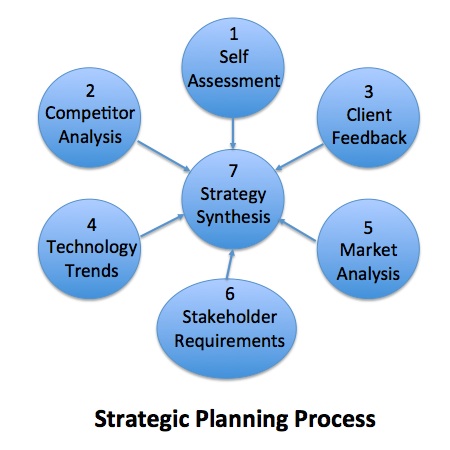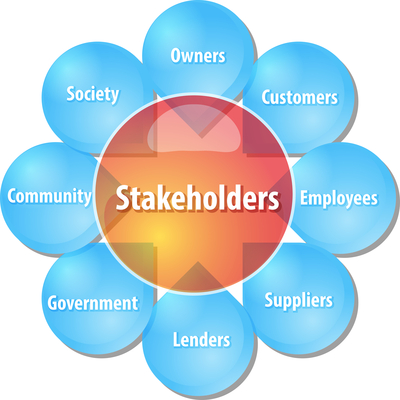In STILE Point 23, we provided an overview of the 7 steps to developing a winning strategy shown in the figure below. The strategic planning process starts with the development or updating of the organization’s mission, vision and values and finishes with a strategy designed to fulfill its mission and achieve its vision. The mission is usually a variation of developing, deploying and exploiting science and technology to create value for the organization depending on the industry sector. In the case of government research institutions, the mission is often expanded to include recommending policies and commercializing technologies based on sound science to stimulate economic and social development.
 STEP 1 SELF ASSESSMENT: A thorough understanding of the organization’s strengths, weaknesses and assets/resources available to it.
STEP 1 SELF ASSESSMENT: A thorough understanding of the organization’s strengths, weaknesses and assets/resources available to it.
STEP 2 COMPETITOR ANALYSIS: The strengths, weaknesses and strategy of competitors’ products and services fighting for the same market space.
STEP 3 CLIENT FEEDBACK: Gaining Intelligence from existing clients on their current problems and future opportunities and the value you bring to their organization.
STEP 4 TECHNOLOGY TRENDS: An awareness of competing and emerging technologies that could disrupt the strategy.
STEP 5 MARKET ANALYSIS: A thorough knowledge of market and industry trends.
STEP 6 STAKEHOLDER REQUIREMENTS: A clear understanding of additional stakeholder requirements which could include regulatory, political and social factors that could positively or negatively affect the organization’s license to operate and its brand image.
STEP 7 STRATEGY SYNTHESIS: Collecting and synthesizing the disparate data and information in steps 1-6 into actionable intelligence on which to make decisions.
In previous STILE Points, we elaborated on the first five steps; self-assessment; competitor analysis, client feedback, technology trends and market analysis. In the current STILE Point, we discuss the importance of factoring in stakeholder requirements into the strategic planning process with the focus on three critical stakeholders; regulators, employees, and the community in which your organization impacts.
In the case of regulators, the sense of importance and urgency is acute. Meeting regulatory requirements such as those required by the Environmental Protection Agency (EPA) or the Food and Drug Administration (FDA) can mean the difference between success or failure of a new product or in the case of a start-up company, the business itself. A successful strategy must not only take into account the competitive advantage of a new product but also its ability to pass muster with the regulatory agency. In the case of the FDA, a new product must meet a threshold efficacy requirement while also providing a margin of safety. In my experience working with dozens of biotechnology clients, I have seen two widely different philosophies and approaches to developing a regulatory strategy.
Some clients view their relationship with the FDA as an adversarial one and the regulatory requirements and process as a barrier to overcome. Regulatory experts are hired to “guide” the development process that presents the minimum amount of data necessary to obtain approval in as fast a time as possible. The attitude is that no matter how much information we provide to the agency; they will always be looking for more. On the other hand, I have worked with clients who view the FDA as collaborators and spend a great deal of time up front in trying to understand what the issues of concern are and how to generate the data to address them.
In my experience, these two strategies mimic the tortoise and hare story. In the adversarial relationship, product data does get reviewed faster but more often than not questions are raised that require additional research and development. These iterations wind up taking much more approval time and costs than if these questions were identified early on and addressed. Taking the time to co-design a development strategy with the FDA study group results in a more comprehensive study plan with a greater chance of initial success. While it may seem to cost more and take more time initially, in the long run it will likely be the most cost effective and fastest route to approval. An important side effect of such a strategy is the development of trust among the regulators about your company’s commitment to safe and efficacious products. Such an approach will require balancing impatient investor desires with the need for a thorough development strategy.
As an example, we worked closely with Johnson and Johnson on their development and regulatory approval of Retin A. From the very beginning, a strategy was developed that focused on answering every question that we could come up with from experimental design to interpretation of the data. This resulted developing a novel apparatus for exposing nude mice to a carefully metered dose of light which became the industry standard for FDA approval.
Although less urgent, but equally important is to incorporate the needs of your employees and community in strategic planning. The concept of corporate social responsibility is a relatively new but I believe will become an increasingly important aspect of an organization’s strategy and vital to its long term viability. Today’s newspapers are filled with stories about corporate greed, CEO salaries, corruption, and income inequality to the point where capitalism’s excesses are being openly protested by the public. Despite capitalism’s powerful economic model that provides financial incentives for solving problems and creating opportunities, the basic goal of maximizing shareholder value by most all major corporations is being challenged. A more comprehensive model for business strategy based on a balanced scorecard* was introduced over 20 years ago, and while many organizations profess to practice it, few in my opinion have really embraced it strategically.
Corporate social responsibility is the belief that business is not divorced from the rest of society and a company should take into account the social, ethical, and environmental effects of its activities to improve the quality of life of its staff and the community around it. As part of a corporate strategy, the goal becomes to balance the needs of all stakeholders: a good return on investment for shareholders; fair and equitable compensation for management and staff; and environmentally sustainable products and industrial processes. Such a strategy will inevitably result in a dramatic improvement in an organization’s brand and have a bottom line payoff.
Unfortunately, while many of today’s corporations have publically endorsed the concept of corporate social responsibility, it has been given lip service for the most part. The trend however is moving more towards sustainable products, whole foods, fair trade practices and the like. Enlightened companies are realizing that consumers are looking to buy from socially responsible companies and that this represents a competitive edge.
I have had direct experience with the benefits of such a strategy while managing an industrial R&D organization embedded in in a small residential community. We were determined to be a good corporate neighbor and incorporated into our strategy several community initiatives. Being a science based organization, we decided that contributing to science education in the local school system would have the most impact. We organized and managed an annual science fair in collaboration with the community’s high school teachers. Many of our senior scientists volunteered their time to judge the exhibits. Very little money was required as most of the effort was pro bono on the part of our staff. Over the years, the science fair became a major annual event that enhanced our image as a good corporate citizen.
In addition to the science fair, there were many other initiatives. Our chief financial officer volunteered his time on the town’s finance committee. Our human resource manager organized several charitable events. We volunteered the use of our land for the town to hold summer concerts on the lawn. Over time we built a reputation as a good corporate neighbor. When we petitioned the town for an expansion of our facilities, it passed with flying colors as we were a trusted member of the community.
We have now discussed all six of the elements that go into developing a strategy. In the next STILE Point, we will discuss synthesizing this information.
- See Robert S. Kaplan and David P. Norton, “Using the Balanced Scorecard as a Strategic Management System,” Harvard Business Review (January-February 1996):




Leave A Comment